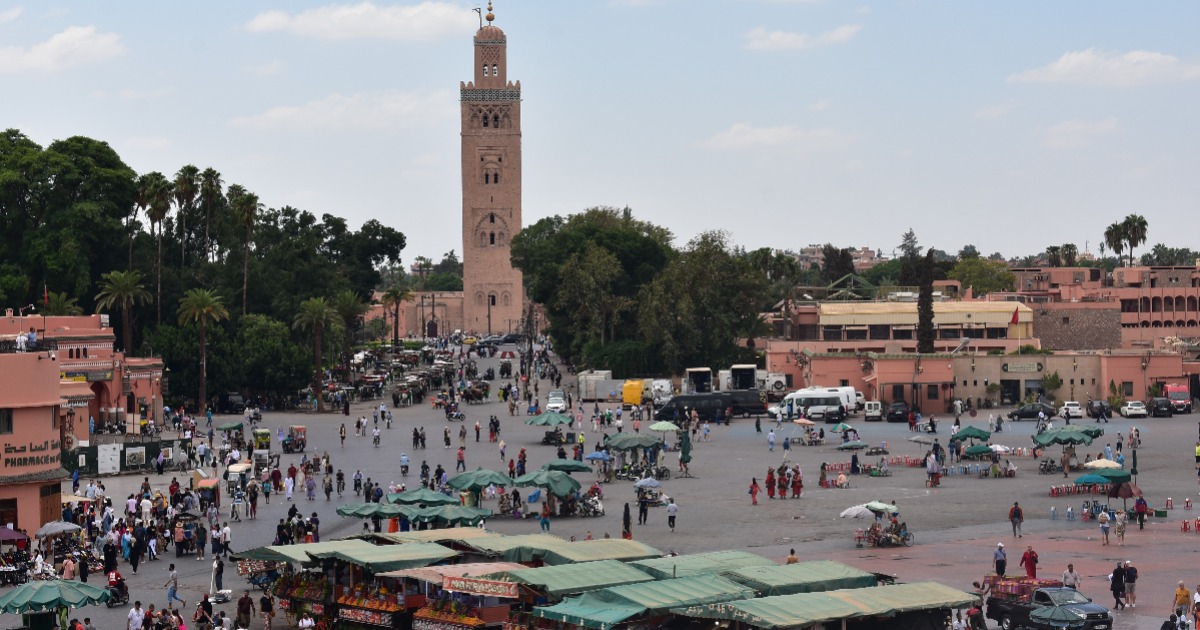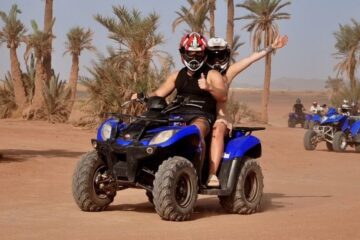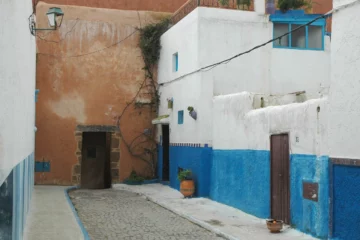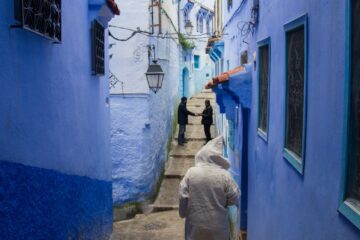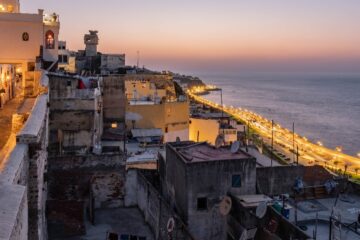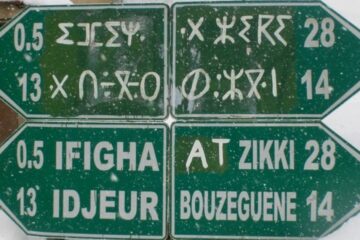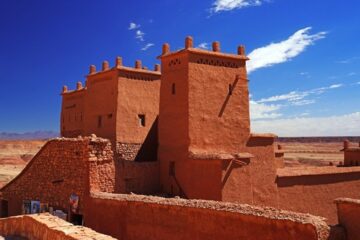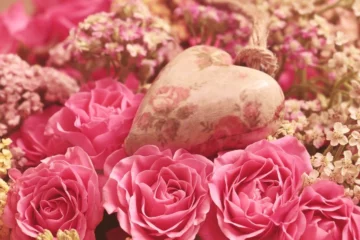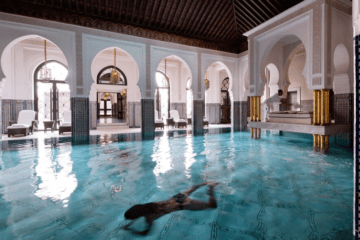Jemaa el-Fna is a large open-air plaza and marketplace in Marrakech’s Medina that is one of the world’s most legendary public squares. For centuries, the throbbing and remarkable Jemaa el Fna has been Marrakech’s nerve center, where medieval and contemporary coexist happily on a daily basis to stage an appealing and interesting sensory show. A trip to Jemaa el Fna is one of the most wonderful travel experiences in the world, and it is a must-see for all cultural tourists. Here is our in-depth guide to Jemaa el Fna to help you make the most of your visit.
What is the location of Jemaa el Fna?
Jemaa el Fna sits in the center of Marrakech’s medina (old town) and is practically impossible to miss.
The irregularly shaped plaza is located between the famous souks to the north of the square and is about 300 meters northeast of the Koutoubia Mosque, another local icon.
Along with a few government buildings, it has hotels, cafés, and restaurants as neighbors. Because it was restricted to car traffic in the early 2000s, Jemaa el Fna is now a pedestrian-only plaza.
Jemaa el Fna History
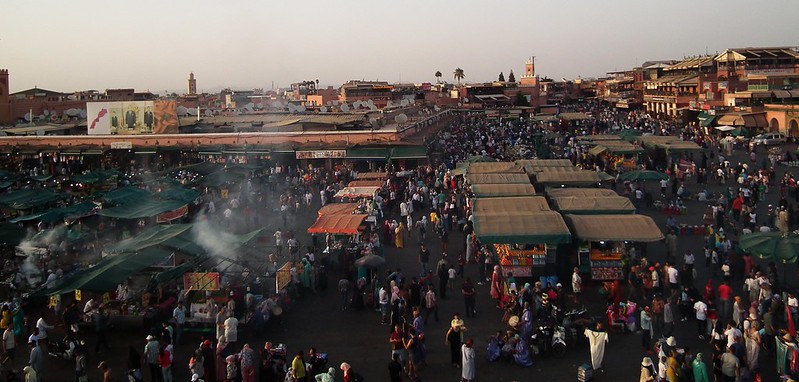
For such an ancient site, it is unclear how or when Jemaa el Fna came to be, or even what its name signifies. One frequent interpretation is that it translates literally as “the gathering/congregation area.”
In Arabic, jemaa denotes “congregation” or “mosque.” This is most likely a reference to an Almoravid dynasty-era mosque that formerly existed on the spot where the plaza now sits. Fna or fana may be translated as “death/extinction” or “a courtyard, space in front of a building.”
Another popular theory regarding how Jemaa el Fna earned its name is that it means “assembly of the dead.” This refers to the tradition of displaying the heads of condemned criminals and sinners on spikes at the Jemaa el Fna, a mid-11th-century rite that lasted far into the 19th century.
Regardless of the historical significance of Jemaa el Fna, the plaza has served as a marketplace and gathering place since the Almoravids built Marrakech in 1070. The Jemaa el Fna has also been employed for political, military, and civic reasons throughout its long and illustrious history.
Today, Jemaa el Fna is best described as a bustling playground where storytellers, snake charmers, soothsayers, acrobats, dancers, and players converge to create a surreal and almost Disneyesque extravaganza, making it one of the best things to do in Marrakech.
Despite the increase in large-scale international travel to Marrakech, it should be highlighted that Jemaa el Fna is mainly a social gathering place and entertainment hub for Moroccans, both local and visiting.
The majority of the entertainment is geared toward the Arabic- and Berber-speaking inhabitants rather than visitors. While there are tourist traps in Jemaa el Fna, a visit here is nevertheless more real than some may assume.
Jemaa el Fna: a UNESCO World Heritage Site
In 2001, UNESCO designated the Jemaa el-Fna plaza as a masterpiece of the oral and intangible heritage of humanity and as the essence and live heritage of Moroccan oral culture. This is consistent with the fact that Marrakech’s Medina has been designated a UNESCO World Heritage Site since 1985.
The decision by UNESCO to safeguard Jemaa el Fna was made in large part thanks to the efforts of the Spanish poet and writer Juan Goytisolo, generally regarded as one of Spain’s best novels.
Goytisolo, who had resided in Marrakech since 1997, was known to be a staunch admirer of the Jemaa el Fna and its oral traditions, both of which appear in his books and short tales.
Goytisolo was concerned that the local authorities’ plans to develop a new tower block with a glass façade and an underground parking lot opposite Jemaa el Fna would irreversibly damage the square’s traditions.
He personally approached UNESCO and begged them to conserve Jemaa el-Fna.
Visiting Jemaa El Fna during the day
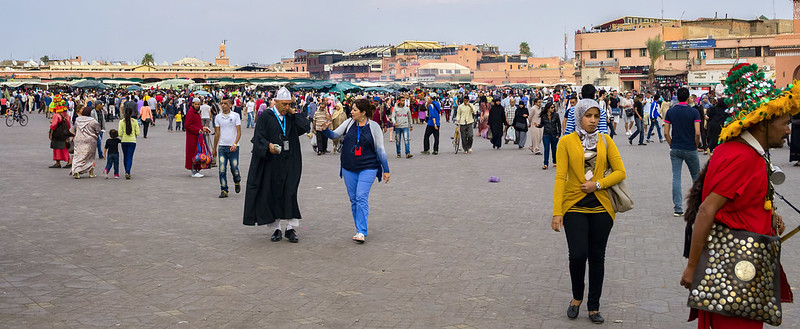
Jemaa el Fna is always accessible to the public since it is an outdoor plaza. What you see in Jemaa el-Fna is totally dependent on the time of day you go.
Morning is when Jemaa el Fna is the least chaotic, with just a few porters lugging baggage on wheeled barrows. The plaza begins to come to life at 9 a.m.
The area is crowded with snake charmers, monkey trainers, water vendors, acrobats, musicians, and henna artists by afternoon.
There is a bustling daily market in the area, with shops offering anything from spices and dried fruits to candies and random trinkets as souvenirs.
The brightly clothed water vendors are another daytime feature of Jemaa el-Fna.
The water vendors, known as gerrab by the locals, ring copper bells as they make their way around the plaza, attracting customers with their brightly colored wide-brimmed hats, studded leather girdles, and necklaces of polished brass cups. They carry amazingly refreshing water in leather pouches.
Observing the toothpullers at Jemaa el Fna is one of the most entertaining shows. With their frightening pliers, these self-proclaimed “dentists” are more than willing to help cash-strapped villagers. They proudly exhibit their most recent extractions in tidy stacks as proof of their competence.
The sight of chained Barbary macaques in diapers being paraded to caper and dance for flung money was the most repugnant thing we saw at Jemaa el Fna.
Seeing cobras being forced to sing for tourists was just as revolting. We often see snake charmers convincing unsuspecting visitors to pose with the regal reptiles draped over their shoulders.
Although Barbary macaques and cobras are both legally protected in Morocco, visitors to Jemaa el Fna will find that local officials often turn a blind eye to such activities.
It is horrible to exploit animals for entertainment; therefore, if you are a good tourist, you will avoid shows that include live animals.
Visiting Jemaa El Fna during the Night
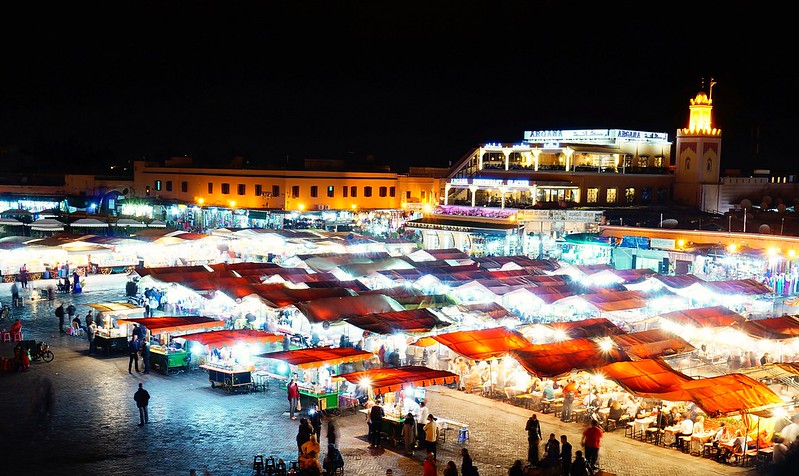
Even though Jemaa el-Fna is bustling throughout the day, the area comes alive at night. The majority of the day’s visitors and entertainers had left the area by this time.
Acrobats, raconteurs, magicians, clowns, jugglers, herbalists, fortune-tellers, and Chleuh dancers take the place of day entertainers. They together produce an ambience that is sometimes referred to as the world’s finest open-air spectacle.
It’s entertaining to witness the medicine-cum-holy men or fakirs at Jemaa el Fna perform miraculous cures over psychic powers. Regal-looking turbaned herbalists are also prevalent, demonstrating Moroccan faith in natural cures.
Desiccated animal parts, pulverized roots, dried herb and spice compounds, and spices are sold as elixirs for anything from impotence to warding off the evil eye.
Fortune-tellers—elderly ladies sitting under umbrellas with packs of Tarot cards telling the destinies of those who dare to know—are also fighting for the public’s attention.
The storytelling ritual is the most traditional and popular form of entertainment in Jemaa el Fna, at least among the natives. Jemaa el Fna’s storytellers usually draw the most audiences.
The art of storytelling has long been an important aspect of Moroccan society, and great raconteurs recite their stories at breakneck speed to the halqa—the entranced listeners who gather to hear tales handed down through generations of storytellers.
Their stories include beggars, thieves, poverty, and wisdom, as well as kings, beautiful ladies, temptations, and wealth. Unfortunately, since all of the tales are performed in Arabic and local Berber dialects, many performances are incomprehensible to international visitors.
However, it is still worthwhile to attend a concert to experience the passionate performances and the rapt crowd.
Transvestite dancers and a scattering of Gnaoua musicians provide entertainment at Jemaa el Fna. Transvestite dancing is an ancient ritual in which males frolic wildly while clothed in women’s attire.
Their dervish-like performances give the goings-on on the plaza a somewhat weird aspect.
The Gnaoau musicians are especially notable for their silky robes, cowrie-trimmed headgear, and the unique instruments they employ, which include a three-stringed bass lute (gimbri) and a pair of metal castanets (garageb).
The Gnaoua, who arrived in Morocco as slaves from Sub-Saharan Africa, are recognized for their particular blues-like sound, thrumming rhythms, and amazing ability to induce a hypnotic, almost trance-like condition.
Gnaoua music, apart from being entertaining, has a deeply rooted spiritual and therapeutic purpose originating from Sufi Islam. Their shows are normally quite low-key, but when the energy and crowd are perfect, their music may go late into the night.
Also read: The 4 Imperial Cities Of Morocco You Should Visit
Food at Jemaa el Fna
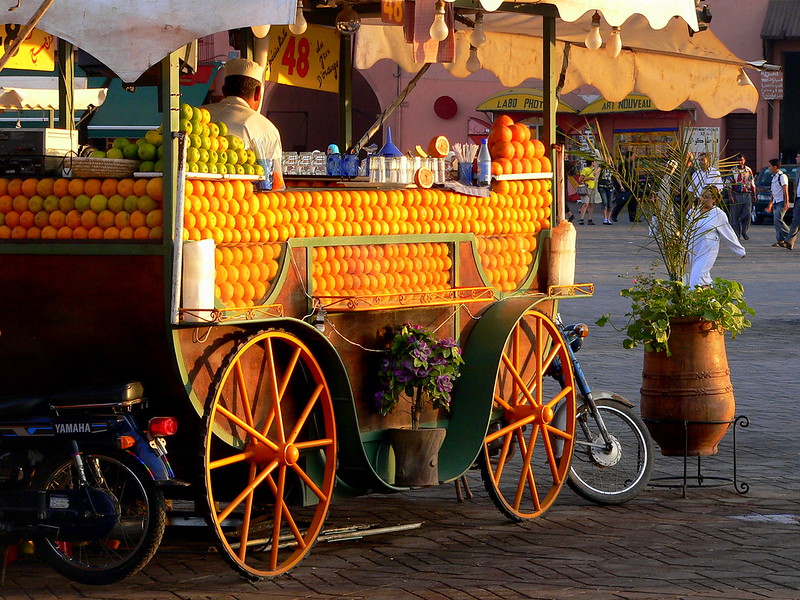
When going through Jemaa el-Fna, one of the first things you’ll notice is the abundance of orange juice kiosks. These orange-adorned kiosks are especially useful on hot days (which are often in Marrakech).
There is nothing like a glass of freshly squeezed orange juice for refreshing or relieving thirst. To get a genuinely ‘fresh’ and unadulterated drink, make sure the oranges are squeezed in front of you. You will not be let down!
As the sun sets, Jemaa el Fna morphs into a massive open-air eating area. On the east side of the plaza, makeshift booths with gas lights are put up, and the air fills with aromatic odors and plumes of cooking smoke.
Tables and seats are arranged to form a large outdoor dining area. A wide variety of Moroccan food is available, with practically every vendor presenting a specialty.
Take a seat at one of the food vendors with locals to get ringside seats to the actual action!
Each evening, new ingredients come, and you have the pleasure of seeing the dish being prepared in front of you. The menu includes spicy merguez sausages, grilled meats, tajines, salads, harira soup, fried fish, and much more.
The food quality varies, but dining here is more about soaking up the ambiance at one of the world’s most unusual and intoxicating places.
Marrakech delicacies like snails in a spicy soup, sheep’s brains, camel spleen impaled hearts, and goat’s skulls complete with teeth and eyeballs are also available in Jemaa el Fna for the more courageous tourists.
The snails are cooked alive, and the soup is greatly sought after for its reputed healing powers. The fragrance wasn’t overpowering, and the texture was chewy.
I tried the snails and found them surprisingly pleasant, although I was terrified of eating offal.
Best Views of Jemaa el Fna
Night or day, the breathtaking scene unfolding at Jemaa el Fna demands to be shot in order to create lasting memories. You’ll need to visit the roof terraces framing the square’s perimeter to obtain the greatest view of Jemaa el Fna.
The nicest of these rooftop terraces may be found at Le Grand Balcon du Café Glacier, which is ideally located at the southern end of Jemaa el Fna to catch the square’s commotion.
Café Glacier is only accessible with the purchase of an overpriced soft drink. Don’t bother ordering meals here since it’s bad and you’ll be wasting your money!
Aside from Café Glacier, Café Argana and Café de France provide panoramic views of Jemaa el-Fna from somewhat different perspectives. These restaurants, like Café Glacier, provide awful cuisine at exorbitant prices.
Visit Jemaa el Fna With These Tips
Strolling through Jemaa el Fna may be a delightful experience, but it can also be rather overwhelming (at least, that’s how Jacky and I felt on our first visit to the plaza).
Indeed, it may get so tiresome that some visitors grow to despise their time here. To help you make the most of your visit to Jemaa el Fna, I’ve compiled a list of top suggestions to keep in mind while touring.
Relax and ignore the hustlers:
If this is your first time to Jemaa el-Fna, you’ll note that it’s home to some of the world’s most aggressive touts.
They’ll grab your arms and shoulders, halt you in your tracks, pursue you, and refuse to accept ‘no’ as an answer. My advice is to be calm and to approach everything with a sense of humor.
You will never appreciate the unique experience of Jemaa el Fna if you are too self-conscious. Competition is tough, and you must keep in mind that this is their source of income.
It might be tough to ignore them, but be strong and tell them you’re not interested, then go about your work. They will ultimately surrender.
Take pictures responsibly:
Remember to snap photos appropriately while going around Jemaa el Fna. Don’t just shove your camera or phone into people’s faces, believing they’ll be glad to have their photographs taken—particularly ladies.
Most Moroccans, in my experience, are reluctant to have their photos taken and will typically make it known that they do not want to be photographed.
Always seek permission before photographing people, and be aware that certain locals, like water vendors or street performers on the Jemaa el-Fna, would want money in exchange for that perfect shot.
Dining:
Avoid the tourist trap food kiosks if you want to eat in Jemaa el Fna in the evening. Always choose a seat where the locals dine to guarantee a genuine eating experience. I would limit myself to soups, fried dishes, and meats.
Avoid shellfish or anything uncooked since there are no freezers to cool the food, and germs might be an issue if it is undercooked.
It’s also a good idea to skip the plates and utensils since they’re cleaned with the same water every day. Order your meal on paper and eat with your hands instead. Finally, drink only bottled water.
Best moment to take a photograph:
For the finest picture chances on Jemaa el-Fna Plaza, go in the late afternoon or around twilight, when both daytime employees and nightly entertainers are out, assuring spectacular vistas.
Carry some cash with you:
When visiting Jemaa el Fna, have a supply of coins and loose currency (Moroccan dirhams) on hand.
There aren’t many places around here that accept credit cards, and you’ll need cash to tip the performers or dine at the food vendors in the plaza. There are a few ATMs located around the area where you can withdraw money.
Keep a watch on your belongings:
Remember to keep an eye on your wallet and other valuables as you reach the Jemaa el Fna, since it is a magnet for pickpockets. I highly advise not bringing any typical tourist trinkets such as watches, jewelry, or a belt wallet.
Don’t support animal torture:
Get up close and personal with the monkey handlers and snake charmers to avoid supporting and encouraging animal abuse. Please do not pose for photos with these wonderful animals that are being abused and utilized purely as tourist attractions.
Stay Alert:
Always be vigilant and streetwise to avoid being duped. Even if someone claims it’s free, don’t take anything for granted.
If someone attempts to offer or sell you anything unlawful, resist the temptation since you will very definitely be detected and detained.
Riads around Jemaa El Fna:
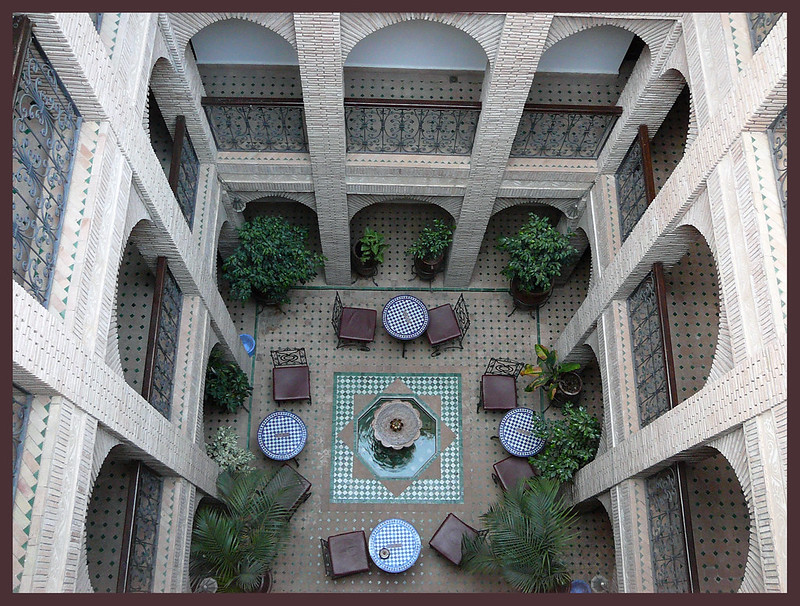
In Marrakech, there are several excellent lodging alternatives, including hotels and riads. A stay in a traditional riad (a typical Moroccan residence with an inner garden or courtyard) in the medina is a necessity if you want to make the most of your vacation to Marrakech.
Conclusion
What are your thoughts? Is it on your bucket list to visit Jemaa el-Fna? Is there anything more in Jemaa el Fna that should not be missed? Please share your ideas in the comments section below!

